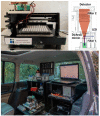Development of an Immunofluorescence Assay Module for Determination of the Mycotoxin Zearalenone in Water
- PMID: 33801263
- PMCID: PMC8000975
- DOI: 10.3390/toxins13030182
Development of an Immunofluorescence Assay Module for Determination of the Mycotoxin Zearalenone in Water
Abstract
Project Aquafluosense is designed to develop prototypes for a fluorescence-based instrumentation setup for in situ measurements of several characteristic parameters of water quality. In the scope of the project an enzyme-linked fluorescent immunoassay (ELFIA) method has been developed for the detection of several environmental xenobiotics, including mycotoxin zearalenone (ZON). ZON, produced by several plant pathogenic Fusarium species, has recently been identified as an emerging pollutant in surface water, presenting a hazard to aquatic ecosystems. Due to its physico-chemical properties, detection of ZON at low concentrations in surface water is a challenging task. The 96-well microplate-based fluorescence instrument is capable of detecting ZON in the concentration range of 0.09-400 ng/mL. The sensitivity and accuracy of the analytical method has been demonstrated by a comparative assessment with detection by high-performance liquid chromatography and by total internal reflection ellipsometry. The limit of detection of the method, 0.09 ng/mL, falls in the low range compared to the other reported immunoassays, but the main advantage of this ELFIA method is its efficacy in combined in situ applications for determination of various important water quality parameters detectable by induced fluorimerty-e.g., total organic carbon content, algal density or the level of other organic micropollutants detectable by immunofluorimetry. In addition, the immunofluorescence module can readily be expanded to other target analytes if proper antibodies are available for detection.
Keywords: competitive immunoassay; fluorescence detection; high-performance liquid chromatography; mycotoxin; total internal reflection ellipsometry; zearalenone.
Conflict of interest statement
The authors declare no conflict of interest.
Figures






Similar articles
-
Development of an Immunofluorescent Capillary Sensor for the Detection of Zearalenone Mycotoxin.Toxins (Basel). 2022 Dec 9;14(12):866. doi: 10.3390/toxins14120866. Toxins (Basel). 2022. PMID: 36548763 Free PMC article.
-
Utilization of a Novel Immunofluorescence Instrument Prototype for the Determination of the Herbicide Glyphosate.Molecules. 2022 Oct 2;27(19):6514. doi: 10.3390/molecules27196514. Molecules. 2022. PMID: 36235051 Free PMC article.
-
An Optical Planar Waveguide-Based Immunosensors for Determination of Fusarium Mycotoxin Zearalenone.Toxins (Basel). 2021 Jan 25;13(2):89. doi: 10.3390/toxins13020089. Toxins (Basel). 2021. PMID: 33504112 Free PMC article.
-
Direct and Competitive Optical Grating Immunosensors for Determination of Fusarium Mycotoxin Zearalenone.Toxins (Basel). 2021 Jan 8;13(1):43. doi: 10.3390/toxins13010043. Toxins (Basel). 2021. PMID: 33430121 Free PMC article.
-
Fusarial toxins: secondary metabolites of Fusarium fungi.Rev Environ Contam Toxicol. 2014;228:101-20. doi: 10.1007/978-3-319-01619-1_5. Rev Environ Contam Toxicol. 2014. PMID: 24162094 Review.
Cited by
-
Development of an Immunofluorescent Capillary Sensor for the Detection of Zearalenone Mycotoxin.Toxins (Basel). 2022 Dec 9;14(12):866. doi: 10.3390/toxins14120866. Toxins (Basel). 2022. PMID: 36548763 Free PMC article.
-
Utilization of a Novel Immunofluorescence Instrument Prototype for the Determination of the Herbicide Glyphosate.Molecules. 2022 Oct 2;27(19):6514. doi: 10.3390/molecules27196514. Molecules. 2022. PMID: 36235051 Free PMC article.
-
Development of Indirect Competitive ELISA and Visualized Multicolor ELISA Based on Gold Nanorods Growth for the Determination of Zearalenone.Foods. 2021 Nov 2;10(11):2654. doi: 10.3390/foods10112654. Foods. 2021. PMID: 34828935 Free PMC article.
-
A sensitive electrochemical aptasensor for zearalenone detection based on target-triggered branched hybridization chain reaction and exonuclease I-assisted recycling.Anal Bioanal Chem. 2023 Aug;415(20):4911-4921. doi: 10.1007/s00216-023-04797-2. Epub 2023 Jun 16. Anal Bioanal Chem. 2023. PMID: 37326832
-
Mycotoxins as Emerging Contaminants. Introduction to the Special Issue "Rapid Detection of Mycotoxin Contamination".Toxins (Basel). 2021 Jul 9;13(7):475. doi: 10.3390/toxins13070475. Toxins (Basel). 2021. PMID: 34357947 Free PMC article.
References
-
- Khaneghah A.M., Fakhri Y., Gahruie H.H., Niakousari M., Sant’Ana A.S. Mycotoxins in cereal-based products during 24 years (1983–2017): A global systematic review. Trends Food Sci. Technol. 2019;91:95–105. doi: 10.1016/j.tifs.2019.06.007. - DOI
-
- Van Der Fels-Klerx H., De Rijk T., Booij C., Goedhart P., Boers E., Zhao C., Waalwijk C., Mol H., Van Der Lee T. Occurrence of Fusarium head blight species and Fusarium mycotoxins in winter wheat in the Netherlands in 2009. Food Addit. Contam. Part A. 2012;29:1716–1726. doi: 10.1080/19440049.2012.685891. - DOI - PubMed
Publication types
MeSH terms
Substances
Grants and funding
LinkOut - more resources
Full Text Sources
Other Literature Sources

